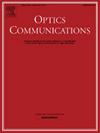利用对偏振敏感的 SMLM 推断染料-光电纳米球系统的相互作用强度
IF 2.2
3区 物理与天体物理
Q2 OPTICS
引用次数: 0
摘要
单分子显微镜是表征荧光团与等离子结构相互作用的有效工具。然而,由于特定信息隐藏在发射中,因此需要进行复杂的评估。在此,我们通过理论和实验研究了等离子金银合金纳米球附近旋转移动荧光团的发射极化。我们在米氏理论的基础上进行了精心计算,考虑了任何尺寸的球形等离子纳米粒子附近染料的旋转流动性。此外,我们还创建了一个简化模型,在偶极子近似有效的情况下,该模型对小纳米粒子发射极化程度的描述精度在 10%以内。我们的研究结果表明,发射极化度与荧光散射关系密切,在共振情况下,发射极化度可达 ∼0.8。使用 AF488 和 Atto647N 染料进行的 DNA-PAINT 单分子定位显微镜实验表明,测得的极化度分布与计算预测的趋势一致。本文章由计算机程序翻译,如有差异,请以英文原文为准。
Using polarization sensitive SMLM to infer the interaction strength of dye-plasmonic nanosphere systems
Single-molecule microscopy is an effective tool for the characterization of fluorophore–plasmonic structure interaction. However, sophisticated evaluation is required as specific information is hidden in the emission. Here, we theoretically and experimentally investigated the emission polarization of rotationally mobile fluorophores near plasmonic Au–Ag alloy nanospheres. We developed an elaborate calculation based on the Mie theory, which considers the rotational mobility of dyes near spherical plasmonic nanoparticles of any size. Furthermore, we have created a simplified model that describes the emission’s degree of polarization within 10% accuracy in the case of small nanoparticles, when dipole approximation is valid. Our results indicate the close relation of the polarization degree of the emission, which can reach up to be in the resonant case, to fluorescence scattering. DNA-PAINT single-molecule localization microscopy experiments conducted using AF488 and Atto647N dyes revealed that the measured polarization degree distribution followed the tendency predicted by calculations.
求助全文
通过发布文献求助,成功后即可免费获取论文全文。
去求助
来源期刊

Optics Communications
物理-光学
CiteScore
5.10
自引率
8.30%
发文量
681
审稿时长
38 days
期刊介绍:
Optics Communications invites original and timely contributions containing new results in various fields of optics and photonics. The journal considers theoretical and experimental research in areas ranging from the fundamental properties of light to technological applications. Topics covered include classical and quantum optics, optical physics and light-matter interactions, lasers, imaging, guided-wave optics and optical information processing. Manuscripts should offer clear evidence of novelty and significance. Papers concentrating on mathematical and computational issues, with limited connection to optics, are not suitable for publication in the Journal. Similarly, small technical advances, or papers concerned only with engineering applications or issues of materials science fall outside the journal scope.
 求助内容:
求助内容: 应助结果提醒方式:
应助结果提醒方式:


